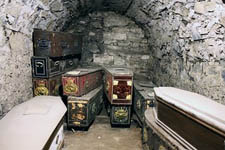St. Michan's
Church
This church, in Dublin, Ireland, is now a Church
of Ireland church, but was constructed on the site of an early
Dutch chapel that had been constructed in 1095 AD, although the
current building would be from a reconstructed church in 1686,
and believed to be the only parish church located on the north
side of Liffey that survived its Viking foundation. The vaults
of the church contain many mummified remains, since the walls in
the vaults were created from limestone, that kept the atmosphere
dry and the perfect conditions necessary of mummification. Some
of these remains includes a 400 year old nun, the Sheares
brothers, John and Henry, that had taken part in the 1798
rebellion and a man's remains that is thought to be that of a
former crusade that stood about six and a half feet tall, with
the feet and right hand severed. Also interred here are those
people that had held the title of Earl of Kenmare, and the
church still holds services here on Sundays, so it is closed to
visitors. The church's organ is one of the oldest in the nation,
still in use and it is thought that George F. Handel would use
it to compose The Messiah. One panel on the organ, that had been
carved from a single block of wood, showcases a number of
musical instruments in high relief, with a penitent's stool, a
chalice from the 16th century and an 18th century pulpit and
font are some of the other outstanding relics located here. The
vaults, however, seem to be the most interesting part of the
church to many visitors, that access the vaults through a narrow
stone stairway, where a tunnel opens and is lined with limestone
and mortar that extends down the long narrow tunnel with small
niches for coffins on each side. Some of these are private and
kept that way with wooden or iron doors, while the remainder are
open. In others, with iron bars across the front, the coffins
are viewed lying in a strange fashion, some bursting apart at
the seams or joints with an arm or leg protruding out, with one
of the open chambers lying the grisly remains of contents that
have been sought by many previous visitors long ago; the Big
Four. These caskets have no tops, with the exposed bodies
covered by a tight, leathery skin, that is covered in a thick
layer of dust. There are 3 coffins across the front, with a
woman on the right, the crusader without feet and hand, with
some accusing the deceased of being a robber, but others saying
because of his size, his feet had to be cut off so he could fit
in the coffin, and a nun on the left.
|

